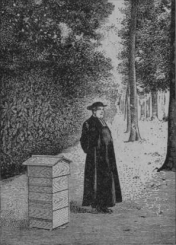
Warré plans
Warré methods
Warré modifications
Warré precursors
Groups / Fora
Google
e-group
Biobees.com
forum
Abbé Warré's book
Beekeeping for All:
Warré describes two methods for making increase by artificial swarming or splitting colonies on pages 98 to 101 of Beekeeping for All.
The second method is used when two colonies are strong and prepared for division but just one split is made. As a result, the second colony loses all its foraging bees to the benefit of the new colony created. We could say that with this second method, the shock of splitting is smaller for all colonies.
Here we add some examples of splitting as described by members of the Warré beekeeping Google (formerly Yahoo) e-group.
John Moerschbacher (Alberta, Canada)
It isn't really necessary to find the queen. One just has to know which box she is in when the split is made. This is somewhat less drastic a manoeuver than Warre's way of finding her (page 102 Beekeeping for All..
1. The box that you want to take away for a split is placed in
the top position on the hive. Make sure it has brood in all stages and some honey. Make
sure also that there is brood in the box(es) to be left behind.
2. Smoke the entrance moderately with cool, white, thick smoke. Wait ten seconds, then
smoke again.
3. Remove the top box onto a stand.
4. Place the queen excluder on the next box.
5. Place the split back on the queen excluder.
6. Wait 15 minutes (during which time many of the nurse bees will go back down to the
brood boxes below)
7. Remove the split. There is no guarantee the queen is in it, but the chances are very
good.
You can introduce a new queen to the original hive (after they have been left queenless
for a day or so), or let them raise their own queen. The latter option will mean no new
brood for about a month.
These kinds of manipulations should always be done when there is substantial nectar coming
in. I would nadir a box onto the split immediately.
I will always prefer letting the colony swarm, but doing walkaway splits are the next best
thing, in my opinion.
Adam Christiansen (NC, USA)
In the first warm spell in February, I feed my bees honey syrup
and pollen patties (from pollen and honey collected from them last season). This
stimulates the queen into laying. I run my Warre's on half frames (see for example here).
As I feed the honey syrup to the bees, I crowd them by not adding boxes. This stimulates
the swarm impulse and the bees make swarm cells. In my opinion, swarm cells make the
strongest splits.
When the swarm cells are capped, I find the queen and move her, a couple of frames of
stores covered, and shake a couple of frames of bees into the new hive.. This hive will go
into the original hive location so that the foragers come back to this new hive. This is
pretty close to how a natural swarm works.
I then divide the frames of the original hive with another box or two (depending on the
amount of brood present and number of bees), making sure each split has several swarm
cells and plenty of bees to cover the brood.
I now have two or three hives where I had one before.
Acknowledgement
This advice has been compiled by various members of the Google (formerly Yahoo) e-group https://groups.google.com/g/warrebeekeeping